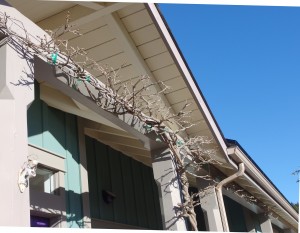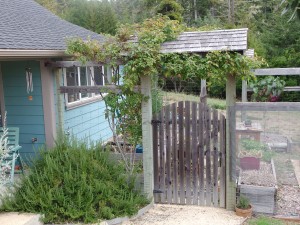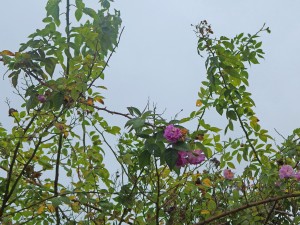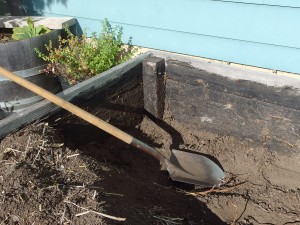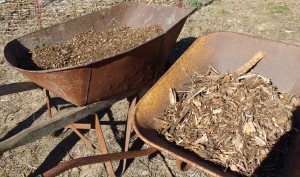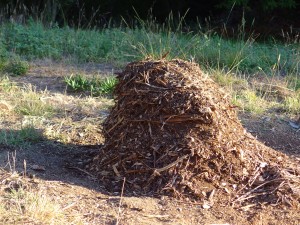Posts Tagged ‘gardening’
Pruning the Wisteria
I spent the morning pruning the wisteria vine that grows along our front porch. Up and down the tallest stepladder, leaning over the porch beam to reach the longest stems, I snipped and thinned. Each time I do this task, I remember with gratitude the workshop I attended years ago at the Elizabeth F. Gamble Garden in Palo Alto. “Be ruthless if you want flowers,” the instructor said. Ruthless I am. Otherwise the new growth pushes between the porch beam and ceiling, wraps itself round the lamp above the front door and seeks to enter the house itself.
Wisteria is not for the faint of heart. In May, as soon as the magnificent double purple flowers have bloomed and dropped, the new stems start growing. If left their own devices, they can reach ten feet in a year. As soon as they threaten to strangle visitors at the front door, I whack back as many as I can reach with my pole pruner. I may have to do this several times during the summer. In fall I haul out the big stepladder and take back all the foliage to somewhere near its supporting wire. However, in our mild coastal climate, the leaves don’t drop until well into the winter. It’s only then that I can see the structure I have trained over the years and can scrutinize each branch that sprouts from the main stem, looking for crossed twigs, dead wood, and stems facing back toward the house.
It’s a strenuous task. But when it is done, the prunings composted and the porch swept, there’s such a sense of satisfaction in looking up at the vine and seeing the shape of it against the house.
A Little House for Poetry
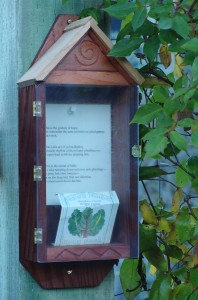 The idea came from an article in the Sept.-Oct. 2013 issue of Poets & Writers Magazine about a project to erect small installations, called poetry boxes, in public places. Their purpose, according to the artist, is to “connect people to landscape by combining poetry, visual art, and nature observation.”
The idea came from an article in the Sept.-Oct. 2013 issue of Poets & Writers Magazine about a project to erect small installations, called poetry boxes, in public places. Their purpose, according to the artist, is to “connect people to landscape by combining poetry, visual art, and nature observation.”
I decided to design a poetry box for myself. A simple little house, with just a touch of decoration: a carved spiral to symbolize the continuity of life, and a line of chevrons to signify water. I have no skill at woodwork, but my husband Tony does, and he readily agreed to take my plan and build it.
Here it is, mounted on the 6” x 6” gatepost of my fenced vegetable garden. The laminated text is thumbtacked to the back of the box, so that I can change it whenever I want to. For its debut, I placed an empty seed packet on the floor of the house and pinned up a few lines from my poem “Winter Greens,” which is published in my collection Rogue Wave at Glass Beach.
This is the gesture of hope:
to remember the taste of fresh-cut salad greens
and act on it.
This is the act of reconciliation:
muscle rhythm of shovel and wheelbarrow,
load upon load to fill the planting box.
This is the sound of faith:
a rake tamping down soil over new plantings—
snap peas, bok choi, lettuces—
tines on the diagonal, first one direction
then crisscrossed down the line.
Battle of the Rose Roots
I should have learned from experience. Years ago, I wondered why plants near a hedge in my Palo Alto garden weren’t doing so well, in spite of soil amendments, regular watering, and other tender loving care. Investigating closer, I found that below the soil surface was a dense mass of tiny white roots. The nourishment stealer was a Banksia rose that had flourished in the hedge for fifty years.
You would think I’d learn and remember. But no … As we designed a deer-fenced vegetable garden for our new home on the edge of the forest in Mendocino, we decided that a covered gate, an English lych-gate, would be a charming touch. And wouldn’t it be romantic to have a rose climbing over it? I’ve always been fond of “Mrs. Cecille Brunner” with its exquisite miniature pink buds.
I planted a climbing “Mrs. B” in a half wine barrel just inside the gate, out of the deer’s reach. Years passed. At a friend’s house I admired another pink climber. She told me its name, “Seven Sisters,” and offered a cutting. The local legend, she told me, was that this rose was originally brought to the Northern California coast by a Russian princess in the early 1800s. Possibly she was the well-born wife of Ivan Kuskoff, commander of the Russian American Company fur trading post at Fort Ross, whose house is still standing, and is now a National Historic Landmark. According to the story, Madame Kuskoff gave cuttings of “Seven Sisters” to friends, who gave cuttings to friends, and so it moved up the coast. I see it everywhere in the gardens of old coast homes, and have met the woman who gave my friend her cutting.
But I digress. Needless to say, my cutting of “Seven Sisters” also found a home in a wine barrel inside my fenced garden. It became a yearly task to prune these enthusiastic climbers before they totally blocked the sun from the vegetables.
This year “Seven Sisters” decided to bloom again just as I was getting out my pruning shears, so she’s still a wild tangle.
But tidy on top doesn’t mean disciplined underneath. This season I noticed that the vegetables in raised beds near the roses were stunted and sad. One scoop with the shovel showed the cause. Nothing for it but to dig out the entire bed.
There’s a layer of hardware cloth on the bottom to keep out the gophers (that’s another story). I’m hoping a couple of layers of weed cloth will deter the rose roots, at least for a few years. My friend, a Master Gardener, laughed when I told her. “You’re the eternal optimist, aren’t you?” she said.
Compost
I love the miracle of compost. There is a circularity to it, the way plants in their dying return nourishment to the soil that sustained their lives. I have compost bins, of course, wire frames in which I layer garden refuse, kitchen scraps and dry material. I compost vegetable matter only, because of our resident wildlife, and keep a wire mesh lid on the currently active bin. It’s not entirely satisfactory. I cannot raise a hot enough temperature to kill all the weeks seeds. I’m envious of our local Mendocino Coast Botanical Gardens, which receives regular donations of spent grain and hops from nearby North Coast Brewing Companyto boost their compost processing temperature.
Right now I’m digging out my favorite kind of compost, a huge pile of chippings from a neighbor’s tree trimming and bush pruning that has sat in the meadow behind the house for about three years. The chippings were not great. Even now, the pile contains a lot of sticks, which I have spread under my orchard trees. They’ll decompose in time, and meanwhile provide some deterrent to the meadow grasses.
Sieved out from the sticks is the treasure: rich black compost, free of weeds, to spread as mulch around the garden. The plants are smiling.
Sweet Peas
The 2012 Mendocino Coast Writers Conference ended last night. This morning I picked sweet peas. Over my four-day absence to run the conference, the stems that had been in bud were in full flourish, and the row of pea plants sprawled even more rampantly over chard and carrots in my vegetable garden. I picked enough to refill vases of crumpled has-beens in my house, enough to give away to a friend, enough to fill yet more vases. I pressed my nose into the bouquet, sweet as the hugs of farewell and murmured words of thanks at the conference’s closing dinner.
The scent restored my faith in myself, both as the director of a successful conference, and as a grower of sweet peas. Back when I was a child in school, growing sweet peas was part of the curriculum, like spelling and arithmetic. Each year the Important Visitor would bring the signup sheet and reveal the wondrous names of new varieties. On Seed Day the visitor would return. Precious pennies would be offered up for hard black miracles. The visitor would give instruction in the mysteries of sweet pea growing. We must dig a trench two feet deep. The layer of compost in the bottom of the trench must be at least six inches before we shoveled back the dug and loosened earth. We must soak the seeds in water overnight, then plant exactly one inch deep, and four apart.
The best on Judgment Day took front row place at the flower show, a ribbon tucked beneath a jam jar that held three specimens, each with four blooms on a long stem. My jar sat humbly at the back. I was racked with guilt for shorted measure on the trench. The ground was hard, and my arms ached. My Dad’s compost pile yielded only a thin layer of partially composted weeds. I had tossed in some fresh grass clippings, but even those did not make up the required six inches. The seeds germinated, but the plants were spindly, and none of their flower stems boasted more than three blooms.
The guilt stayed with me all my life. Not enough my love for their bright beauty, not enough my penitence. I was cast down.
This year I decided to try again. A raised vegetable bed had an empty row next to a sheltered wall covered with a strong wire trellis. Remembering my past efforts, I figured that would be enough space. I dug in a bag of soil conditioner with an impressive ingredients list: composted firbark, chicken manure, earthworm castings, bat guano and kelp meal. I planted my seeds, an old-fashioned mix from Renee’s Garden, careful to places them one inch deep and four apart.
The seeds grew. And grew. I wound string from post to post to hold the plants against the trelllis. More string. A length of chicken wire that bulged and sagged. A couple of tomato frames. Soon I gave up. The chard was running to seed anyway, and the carrots were mature enough to survive the shade.
This morning as I teetered on a step-stool to pick the flowers, the thought came to me that their exuberant growth was akin to the joy conference participants were expressing. The Mendocino Coast Writers Conference has as its mission to offer a place where writers find encouragement, expertise and inspiration. This year it all came together. A brilliant group of faculty shared their expertise with participants dedicated to improving their craft, nurtured by a team of volunteers so cohesive that the flow of events was seamless.
Today we’re all exhausted and resting up. Tomorrow we start planning MCWC 2013.
Prison Guard-ening
On top of the roadbank, I am fastening circles of heavy wire mesh around young Leyland Cypresses. A passing neighbor calls a greeting. “Prison guard-ening?” she asks.
“Yeah,” I reply with a shrug of despair. She too is a gardener. She understands.
Ever since my husband and I built this house at the edge of the forest, we have tried to live in respectful community with the creatures who were here before us. Jackrabbits, foxes and bobcats use our ground-level front porch as a convenient highway. My vegetable garden is fenced off, but the resident blacktailed deer amble through the rest of the garden wherever they please. They even help by pulling juicy weeds from among the deer-resistant perennials and by keeping down the path to the compost bins more efficiently than a lawn-mower.
The only problem I have is with the bucks, who scrape off the velvet covering their antlers by rubbing them against young trees and shrubs. Already some of the cypresses show the telltale signs: a snapped-off branch or frond turning brown, a length of the trunk rubbed raw. It’s a mating signal, I understand, with several facets: the visual sign left by the buck’s rubbing, chemical signals from glands on the buck’s face, and the sound of the buck thrashing branches of the tree on which it is rubbing. I once watched a large buck do battle with a stiff and spiny Ceonothus bush by the driveway. Again and again he attacked, as if determined to demolish it. Here on this roadbank I have lost a Pacific Wax Myrtle and a couple of Shore Pines to such opponents. The Cypresses are a replacement, to help fill in a windbreak against our fierce nor’westers. I can’t afford to lose them too.
The prison cages are unsightly, and don’t fit with the natural landscape I’d like to have. But Cypresses grow quickly; soon their foliage will hide the wire. Sometimes compromises must be made.
Striking a Balance
A gloriously clear day after the first big rain of the season, and the garden calls. Where to start? I need to strike a balance between our enjoyment of beauty and the garden’s needs. The lavender still gives off its evocative scent, and its color is still purple, a gray-purple, like twilight clouds. But if I leave it much longer the stems will die off. Besides, more rain is due in a couple of days, so soon the soil will be too wet to walk on. The task has to be done today.
Even now, where to cut is a challenge. Snip too high, and each rounded bush will resemble a pincushion. Too low, below where a small gray-green pair of leaves has sprouted, and the stem will die anyway. I don’t have time to manicure each individual stem. I take a breath, grab a handful of stems, and cut.
A flotilla of coyote bush seeds sails by on the wind. Negotiating the balance between garden plantings and native vegetation on this stretch of the Mendocino Coast requires the patience and skill of a diplomat. Coyote bush was here first, and provides excellent forage for the small, seed-eating birds that flock here in the fall. Douglas fir grows here too, and Douglas iris, and blue-eyed grass. Again, a balance. The Douglas fir seedlings have to go if they are close to the house. Iris and blue-eyed grass get to stay. Coyote bush, the most prolific, I allow on the outskirts of the garden. But here where it would crowd out the lavender, no. I reach down and yank out babies from between the lavender bushes.
Vegetable Garden, Take 2
My March gardening enthusiasm was a flop. Of all the seeds I planted, only lettuce, peas, fava beans and a few chard came up. Creepy-crawlies quickly demolished the chard. The weather stayed cold and wet. Weeds flourished. I turned my back. Then May arrived with its soft days, and I was tempted once again. This time I hied me to my favorite local nursery, North Star, where I found lovingly grown organic vegetable starts. I brought home chard, red cabbage, kale, basil, parsley, and two tomato plants, Oregon Spring and Sweet 100. The peas are coming in to harvest. The garlic looks happy. For now, optimism triumphs.
Garlic
I planted garlic this afternoon. I’m running a little late. My friend who lives at Comptche, inland from here, and grows beautiful garlic, likes to plant at Winter Solstice and harvest at Summer Solstice. But I figure January 2 is close enough. Anyway, the solstice was rainy, and today was sunny and mild, an excellent day for being outdoors. After spading in compost from a well-matured pile, I selected a good-sized head from last year’s crop, broke it apart, and dropped each fine fat clove into its hole.
The rest of last year’s crop hangs in a decorative sheaf by my kitchen window, where it’s convenient to clip off a head when I need to replenish my Wild River Pottery garlic jar. I haven’t yet figured out how to make garlic braids like my friend in Comptche. Maybe this year …
